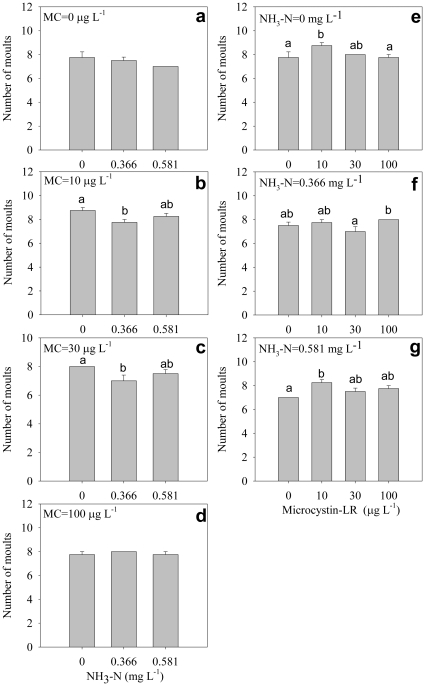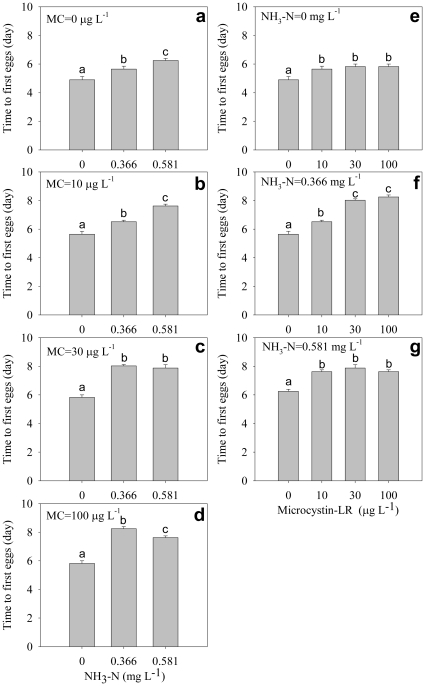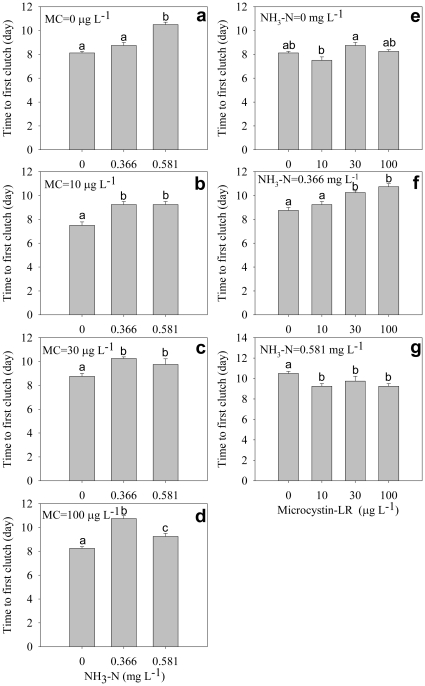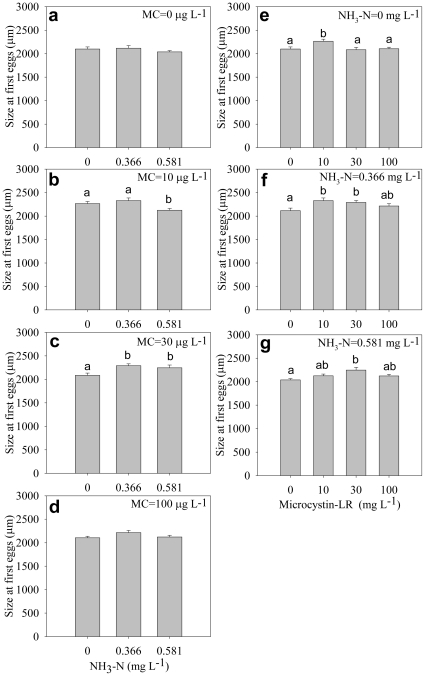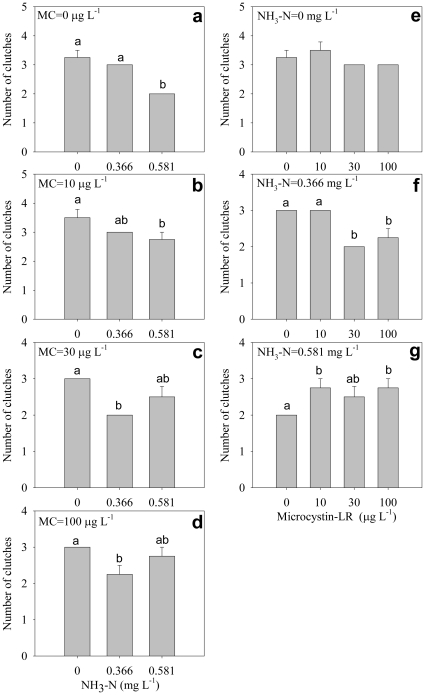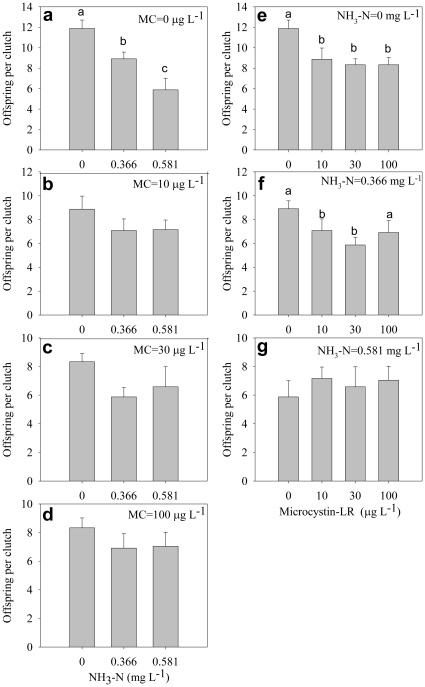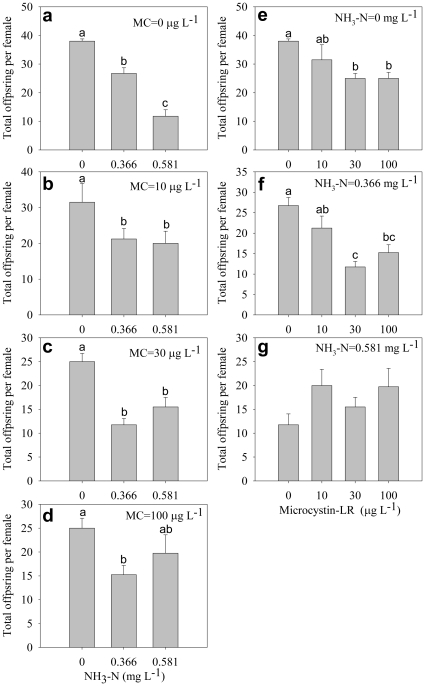Abstract
The occurrence of Microcystis blooms is a worldwide concern that has caused numerous adverse effects on water quality and lake ecology. Elevated ammonia and microcystin concentrations co-occur during the degradation of Microcystis blooms and are toxic to aquatic organisms; we studied the relative and combined effects of these on the life history of the model organism Daphnia magna. Ammonia and microcystin-LR treatments were: 0, 0.366, 0.581 mg L−1 and 0, 10, 30, 100 µg L−1, respectively. Experiments followed a fully factorial design. Incubations were 14 d and recorded the following life-history traits: number of moults, time to first batch of eggs, time to first clutch, size at first batch of eggs, size at first clutch, number of clutches per female, number of offspring per clutch, and total offspring per female. Both ammonia and microcystin were detrimental to most life-history traits. Interactive effects of the toxins occurred for five traits: the time to first batch of eggs appearing in the brood pouch, time to first clutch, size at first clutch, number of clutches, and total offspring per female. The interactive effects of ammonia and microcystin appeared to be synergistic on some parameters (e.g., time to first eggs) and antagonistic on others (e.g., total offspring per female). In conclusion, the released toxins during the degradation of Microcystis blooms would result, according to our data, in substantially negative effect on D. magna.
Introduction
Cyanobacterial blooms occur worldwide in eutrophic lakes and reservoirs [1]. Such blooms are of great ecological concern, as many genera of bloom-forming cyanobaceria produce cyanotoxins [1]–[3]. Furthermore, there is an expectation that such blooms are likely to increase in prevalence and magnitude in the future, especially with climate change [4]. Microcystins, which are cyclic heptapeptides and a main group of the cyanotoxins, are mainly retained within the producer-cells during cyanobacterial bloom development [5]. Upon ingestion, microcystins are actively absorbed by fish, birds, and mammals, and have adverse effects on these aquatic organisms [6]–[8].
To date, concentrations of dissolved microcystins have been measured to be generally <10 µg L−1 [9], [10]. However, recent studies have revealed much higher levels. Microcystin levels can be as high as 10 µg L−1 in localized regions of eutrophic lakes: e.g. this has been observed in Lake Taihu, which is typical of many lakes in the Asian subcontinent [10], and especially during the water crisis of Lake Taihu in 2007, microcystin concentrations reached >15 µg L−1 [11]. Furthermore, in a few cases, microcystin levels be >1800 µg L−1 when toxins are released into water after lysis of cyanobacterial cells, during the collapse of heavy blooms [12], [13]. These observations of high levels, which may become more common as cyanobacterial blooms increase in frequency and become more pronounced [4], stimulated us to examine a range of concentrations that include extremely high concentrations. The released toxins can then come into contact with a wide range of aquatic organisms and have deleterious effects on them [3], [5], [7], [8], [14]–[16]. Specially, microcystin inhibits feeding, reduces growth, and increases mortality in cladocerans [17]–[20], and in particular, the variant microcystin-LR exerts strong toxic effects on Daphnia [18], [21]–[26].
In general, due to the degradation of organic martial formed by phytoplankton blooms, ammonia can be produced [27]. Such ammonia levels normally are very low, except under conditions of rapid decomposition of organic matter. Thus, like microcystin, during the degradation of heavy Microcystis blooms, elevated concentrations of ammonia occur and can reach surprisingly high levels: e.g., 0.2–3.4 mg L−1 in areas of Lake Taihu at specific times [28] and ∼4 mg L−1 with localized peaks of ∼12 mg L−1 during the water crisis in the same lake [11]. Also, total ammonia in localized regions of other freshwaters, e.g. the Mississippi, can be on the order of is about 0.07–4 mg L−1 [29]. It is well accepted that high ammonia levels are deleterious to cladocerans and can result in mortality, inhibited growth, and reduced reproductive performance [30]–[35]; here we, therefore, considered medium and very high levels of this toxin, following the same arguments made for microcystin, above. Finally, and importantly, it might also be expected that when ammonia and microcystin are simultaneously released, and persist for days in the region of blooms [9], that they have combined impacts on aquatic organisms, especially cladocerans; however, there is little, if any, information available on their combined effects.
It is clearly important to examine the influence of toxins on cladocerans, as they are generally the dominant zooplankton in freshwaters, contributing up to 80% of the secondary production [33]. Furthermore, they are an important component of aquatic food webs, acting as major consumers of primary production and as a major food source for fish and invertebrate predators [33]. Species of Daphnia tend to be the dominant caldocerans and are model organisms for studying a range of issues [36]–[38]. Specifically, to fully understand how external factors affect Daphnia, many studies carefully resolve their influence on a range of distinct life history traits [26], [35], [39].
Here, therefore, we have focused on the combined effects of ammonia and microcystin, two of the main toxins that arise as end products of Microcystis blooms, on the life-history traits of a model cladoceran. Our research employs the model species D. magna, which has been used for a range of ecophysiological, behavioral, and developmental studies. For instance, D. magna has been used to reveal the unexpected toxicity of fatty acids on zooplankton [40], the chronic toxicity of NOx to the crustacean [36], and the toxicity of nanoparticles on freshwater organisms [41]. Furthermore, several studies directly relate to cyanobacterial toxins have been conducted on this species, making D. magna an even more relevant model for our purposes: e.g. chronic toxicity of microcystin [42], and effects of microcystin-LR on biotransformation and oxidative stress [43].
Specifically, to obtain well-controlled and repeatable results that will allow further exploration, we chose a reliable clone of D. magna that has been maintained in laboratory for more than 10 years. We hypothesized that most life-history traits of D. magna will not only be adversely affected by ammonia and microcystin independently, but interactive effects between the two toxins will occur. Surprisingly, our data reveal that interactive effects occurred, but these were both synergistic and antagonistic, depending on the life-history traits. Our work thus stimulates a new avenue for toxicological studies, specifically on cladocera and in general on freshwater zooplankton.
Materials and Methods
Test organism
A laboratory clone of Daphnia magna, maintained for >10 years, was cultured in 200 mL beakers and fed Scenedesmus obliquus, at 25°C, under fluorescent light at 40 µmol photons m−2 s−1, with a light-dark period of 12∶12 h. All experiments were conducted under these conditions.
Experimental design
New-born (<24 h-old) D. magna, taken from a single mother (F0) in a stock culture, were isolated and grown individually in 50 mL beakers and fed daily on S. obliquus (5.0×104 cells mL−1). Experimental lines (F1, F2) were conditioned for maternal effects under constant conditions for two generations prior to experiments, with each new generation arising from randomly chosen individuals from the third clutch of the previous generation.
Experimental animals (F3) were placed randomly in 50-mL beakers. Each beaker contained one experimental animal to avoid density effects [44], and each treatment was replicated (n = 4). Ammonia test solutions were prepared by dissolving ammonium chloride (NH4Cl) in de-chlorinated tap water. NH3-N concentrations were calculated using the general equation of bases [45]:
where, the calculation of pKa is based on the equation [45]: pKa = 0.09018+2729.92/T, (T is in °K), pH was stable at 7.5. Based on the toxin levels in the field during degradation of heavy Microcystis blooms, un-ionized ammonia nitrogen concentrations (NH3-N) and purified microcystin-LR (MC-LR) concentrations (Express, Beijing, China) treatments were: 0, 0.366, 0.581 mg L−1 and 0, 10, 30, 100 µg L−1, respectively. Experiments followed a fully-factorial design; i.e. there were 12 treatment combinations. To maintain constant ammonia and microcystin concentrations, test solutions were replaced every two days (preliminary data indicated this maintained stable levels). Experimental conditions were identical to those described above for culturing, and S. obliquus concentration was maintained at 5.0×104 cells mL−1.
The animals were exposed to the test solutions for 14 days. During the 14-day exposure, the following parameters were recorded. The survival and moults (i.e. shed carapaces) were monitored daily. Body length was measured from above the eye to the base of the tail spine daily. Offspring production was measured daily; once counted these were removed. Also recorded were: the time to first batch of eggs appearing in the brood pouch; the time to first clutch; the size at first batch of eggs; the size at first clutch; the number of clutches per female; the number of offspring in each clutch; and the total number of offspring per female.
Statistical analysis
Treatment effects were assessed by two-way ANOVA followed by Duncan's multiple range test (α = 0.05). Data are presented as means ± 1 SE, with different letter to indicate lack of significant differences.
Results
Survival and moults
Experimental animals in all treatments survived during the exposure and the recovery period. Two-way ANOVA showed both ammonia and microcystin had significant effects on number of moults, but their effects were independent, i.e. no interactive effect of ammonia and microcystin on number of moults (Table 1). Generally, number of moults decreased with increasing ammonia concentration under mid-dose microcystin conditions (Figure 1b–c), whereas the presence of microcystin increased number of moults under any ammonia concentrations, even significant effects were detected in some microcystin concentrations (Figure 1e–g).
Table 1. Results from two-way ANOVA for the factors ammonia (NH3-N) and microcystin-LR (MC-LR) for each response variable.
| Traits | Source of variation | DF | SS | MS | F | P |
| Number of moults | NH3-N | 2 | 2.375 | 1.188 | 4.071 | 0.025 |
| MC-LR | 3 | 5.167 | 1.722 | 5.905 | 0.002 | |
| NH3-N×MC | 6 | 2.958 | 0.493 | 1.690 | 0.152 | |
| Time to first eggs | NH3-N | 2 | 30.466 | 15.233 | 131.430 | <0.001 |
| MC-LR | 3 | 21.527 | 7.176 | 61.912 | <0.001 | |
| NH3-N×MC | 6 | 5.797 | 0.966 | 8.336 | <0.001 | |
| Time to first clutch | NH3-N | 2 | 26.073 | 13.036 | 49.728 | <0.001 |
| MC-LR | 3 | 5.807 | 1.936 | 7.384 | <0.001 | |
| NH3-N×MC | 6 | 11.552 | 1.925 | 7.344 | <0.001 | |
| Size at first eggs | NH3-N | 2 | 111190.912 | 55595.456 | 6.831 | 0.003 |
| MC-LR | 3 | 170623.804 | 56874.601 | 6.988 | <0.001 | |
| NH3-N×MC | 6 | 113802.785 | 18967.131 | 2.331 | 0.053 | |
| Size at first clutch | NH3-N | 2 | 45917.540 | 22958.770 | 1.721 | 0.193 |
| MC-LR | 3 | 84585.525 | 28195.175 | 2.114 | 0.116 | |
| NH3-N×MC | 6 | 303777.888 | 50629.648 | 3.795 | 0.005 | |
| Number of clutches | NH3-N | 2 | 4.625 | 2.313 | 16.650 | <0.001 |
| MC-LR | 3 | 2.167 | 0.722 | 5.200 | 0.004 | |
| NH3-N×MC | 6 | 3.208 | 0.535 | 3.850 | 0.005 | |
| Number of offspring per clutch | NH3-N | 2 | 64.823 | 32.411 | 9.328 | <0.001 |
| MC-LR | 3 | 24.863 | 8.288 | 2.385 | 0.085 | |
| NH3-N×MC | 6 | 33.094 | 5.516 | 1.587 | 0.179 | |
| Total offspring per female | NH3-N | 2 | 1600.167 | 800.083 | 26.956 | <0.001 |
| MC-LR | 3 | 505.750 | 168.583 | 5.680 | 0.003 | |
| NH3-N×MC | 6 | 669.500 | 111.583 | 3.759 | 0.005 |
Figure 1. Number of moults.
Effect of ammonia under different microcystin-LR concentrations (a–d) and the effect of microcystin-LR under different ammonia concentrations (e–g) on number of moults. Error bars indicate 1 SE (some error bars are too small and covered), and different letters denote significant difference at P<0.05.
Age and size at first reproduction
Both ammonia and microcystin significantly delayed time to first eggs and time to first clutch, and there was significant interaction between ammonia and microcystin on time to first eggs and first clutch (Table 1). Generally, time to first eggs was delayed with increasing ammonia concentration under any microcystin concentrations (Figure 2a–d); it was also delayed with increasing microcystin concentration under any ammonia concentrations (Figure 2e–g). The time to first clutch was delayed with increasing ammonia concentration under all microcystin concentrations (Figure 3a–d). Interestingly, under high ammonia concentrations, the presence of microcystin significantly alleviated the delayed effects of ammonia on time to first clutch (Figure 3g), although time to first clutch was delayed by microcystin under lower or no ammonia conditions (Figure 3e–f).
Figure 2. Time to first eggs.
Effect of ammonia under different microcystin-LR concentrations (a–d) and the effect of microcystin-LR under different ammonia concentrations (e–g) on time to first eggs. Error bars indicate 1 SE, and different letters denote significant difference at P<0.05.
Figure 3. Time to first clutch.
Effect of ammonia under different microcystin-LR concentrations (a–d) and the effect of microcystin-LR under different ammonia concentrations (e–g) on time to first clutch. Error bars indicate 1 SE, and different letters denote significant difference at P<0.05.
The size at first eggs was significantly affected by ammonia and microcystin (Table 1). In general, size at first eggs increased with increasing microycstin concentration (Figure 4e–g), but the effect of ammonia on size at first eggs was irregular (Figure 4a–d). Surprisingly, size at first clutch significantly decreased under high ammonia and high microcystin (Figure 5a,e) but remained unchanged under mixed toxins with high concentrations (Figure 5d,g), indicating significant interactive effect of ammonia and microcystin on size at first clutch (Table 1).
Figure 4. Size at first eggs.
Effect of ammonia under different microcystin-LR concentrations (a–d) and the effect of microcystin-LR under different ammonia concentrations (e–g) on size at first eggs. Error bars indicate 1 SE, and different letters denote significant difference at P<0.05.
Figure 5. Size at first clutch.
Effect of ammonia under different microcystin-LR concentrations (a–d) and the effect of microcystin-LR under different ammonia concentrations (e–g) on size at first clutch. Error bars indicate 1 SE, and different letters denote significant difference at P<0.05.
Clutches and offspring
Number of clutches decreased significantly with increasing ammonia concentration under all microcystin concentrations (Figure 6a–d), but the effects of microcystin on number of clutches under different ammonia concentrations were complex and seemed irregular: number of clutches was not significantly influenced by microcystin without ammonia (Figure 6e); under mid-dose ammonia, the number of clutches decreased significantly with increasing microcystin concentration (Figure 6f); under high-dose ammonia, the number of clutches increased significantly with increasing microcystin concentration (Figure 6g). There was significant interactive effect of ammonia and microcystin on the number of clutches (Table 1).
Figure 6. Number of clutches.
Effect of ammonia under different microcystin-LR concentrations (a–d) and the effect of microcystin-LR under different ammonia concentrations (e–g) on number of clutches. Error bars indicate 1 SE (some error bars are too small and covered), and different letters denote significant difference at P<0.05.
The number of offspring per clutch decreased significantly with increasing ammonia concentration without microcystin (Figure 7a), but no significant difference occurred among different ammonia concentrations under any microcystin concentrations (Figure 7b–d). Under lower ammonia concentrations, microcystin significantly decreased the number of offspring per clutch (Figure 7e, f), whereas under high ammonia concentrations, no significant difference occurred among different microcystin concentrations (Figure 7g).
Figure 7. Number of offspring per clutch.
Effect of ammonia under different microcystin-LR concentrations (a–d) and the effect of microcystin-LR under different ammonia concentrations (e–g) on number of offspring per clutch. Error bars indicate 1 SE, and different letters denote significant difference at P<0.05.
The total offspring per female decreased significantly with increasing ammonia concentration under all microcystin concentrations (Figure 8a–d). Under lower ammonia concentrations, microcystin significantly decreased the total offspring per female (Figure 8e,f), whereas under high ammonia concentrations, no significant difference occurred among the different microcystin concentrations (Figure 8g).
Figure 8. Total offspring per female.
Effect of ammonia under different microcystin-LR concentrations (a–d) and the effect of microcystin-LR under different ammonia concentrations (e–g) on total offspring per female. Error bars indicate 1 SE, and different letters denote significant difference at P<0.05.
Discussion
Using the model species Daphina magna, we investigated the combined effects of ammonia and microcystin-LR on life-history traits. Our main finding was that both ammonia and microcystin are substantially detrimental to D. magna reproduction, and expected maximum levels of ammonia [28] seemed more harmful than expected maximum levels of microcystin [9], [10]. Furthermore, the interactive effects of ammonia and microcystin occurred for most of the life-history traits; i.e. of the eight traits examined, interactive effects of microcystin and ammonia occurred for five (Table 1): time to first batch of eggs appearing in the brood pouch, time to first clutch, size at first clutch, number of clutches, and total offspring per female.
We note that although there were statistically significant effects for some of the response variables, the magnitude of the effects for many of the variables at most is ∼5 to 10%; this is especially so for the developmental variables such as time to first batch of eggs appearing in the brood pouch, time to first clutch, and size at first clutch. In contrast, the reproductive variables (number of clutches and total offspring per female), which will have direct effects on population growth, changed by as much as 50% due to treatments, and interaction altered these in some cases by ∼10–20%. As indicated in the Introduction, the specifics of these changes may vary depending on the experimental organism of study, so we shall not place emphasis on details. Rather, we use these data to illustrate that in a 14-day incubation there can be subtle and dramatic influences of these toxins on zooplankton, individually and in combination. Given predictions that cyanobacterial blooms will increase in frequency and magnitude in the future [4], we might anticipate that these individual responses, which will influence exponential population growth and competitive advantages may have pronounced effects on populations and communities. Below, in more detail, we examine these toxins independently and then consider the implication of their interactive effects.
Ammonia is toxic to most aquatic organisms, including arthropods and fish, with a range of physiological consequences [46]–[48]. We indicate that sub-lethal ammonia levels are detrimental to D. magna reproduction, causing delayed maturity, reductions in offspring production, and affecting maternal growth and size at maturity. Such chronic consequences of ammonia toxicity on cladocerans are well understood for other species [30]–[33], [35]. Thus, we support an increasing body of literature on the problems caused by sub-lethal ammonia concentrations and maintain that its generation and accumulation must be managed to protect aquatic ecosystems. For instance, due to bacterial degradation of Microcystis blooms maximum total ammonia (including ionized ammonia and un-ionized ammonia) levels in lakes can be on the order of 0.2–3.4 mg L−1 (e.g. in certain areas of Lake Taihu at specific times) [28], which would result, according to our data, in substantially negative effect on D. magna.
Microcystin-LR is a hepatotoxin produced by several cyanobacteria [49] that affects both vertebrates [50] and invertebrates [18]. Microcystin induces oxidative stress and inhibits protein phosphatases, which are main mechanisms of its toxicity [51]–[53]. Furthermore, microcystin-LR reduces Daphnia filtration rate, inhibiting feeding [19]. However, both chronic and acute toxicity of Microcystis blooms and toxins on Daphnia are variable, and unexpected levels of tolerance to microcystins by Daphnia occurs [26], [42], [54], [55]. For instance, Dao et al. [56] observed reduced neonate production and shortened time to maturity for D. magna at 50 µg L−1 of microcystin-LR. We noted similar reduced effect of microcystin on offspring produced per clutch (a parameter akin to neonate production) and total offspring per female. Meanwhile, we also noted microcystin significantly delayed time to first eggs, which is inconsistent with some other studies, probably suggesting the strain we used is more sensitive than some other studied strains [39], [56]. Also, purified microcystin seems, in some cases, not to be detrimental to Daphnia [39], or it only does so under very high concentrations [18].
The differences in tolerance to microcystin are probably due to the long-term maintenance of some species or clones under pristine laboratory conditions (such as the clone used in this experiment), while others, more recently isolated, have become adapted to microcysin as they regularly experiences Microcystis blooms [39], [57]–[59]. In our experiments, the clone of D. magna was maintained in the laboratory for more than 10 years, and probably has either lost its tolerance to microcystin or has not developed a resistance to it through regular exposure; in either case, our data can then be used to provide a “worst-case scenario” assessment of cyanobacterial blooms. For instance, as blooms are becoming more prevalent globally, our data are especially relevant to areas where blooms are becoming a problem.
The interactive effects of ammonia and microcystin occurred for the five traits (Table 1): the time to first batch of eggs appearing in the brood pouch, time to first clutch, size at first clutch, number of clutches, and total offspring per female. Interestingly, it seems that the interactive effects of ammonia and microcystin are synergistic on some parameters and but antagonistic on some other parameters. For example, a synergistic effect was found on the time to first eggs, i.e. D. magna confronted simultaneously with ammonia and microcystin, delays its time to produce the first clutch of eggs, compared with those exposed to a single toxin (Figure 2). In contrast, under lower ammonia concentrations, microcystin significantly decreased total offspring per female (Figure 8e,f), whereas under high ammonia concentrations, no difference occurred among different microcystin concentrations (Figure 8g), indicating an antagonistic effect. Another antagonistic effect occurred for the time to first clutch, under high ammonia concentrations: the presence of microcystin alleviated the delayed effects of ammonia on time to first clutch (Figure 3g), which is similar to the effect of nitrite and microcystin on Daphnia obtusa [39]. Thus, the above phenomenon suggested that combined effects of ammonia and microcystin on different traits of life-history are complex and unintuitive. We suggest, given the importance of Daphnia in food webs and the growing concerns regarding cyanobacterial blooms [1], [33], that there now is a need to rigorously assess the mechanism behind these phenomenon. We also emphasize that our results on this one model taxon should stimulate similar experiments on other cladocerans and freshwater zooplankton, as differences will undoubtedly occur between genera, species, and even clones. Revealing such variation in the response to toxins may indicate the robustness of the zooplankton community to cyanobacterial blooms.
Conclusion
We support the wide body of literature that recognizes ammonia and microcystin as toxins. Both ammonia and microcystin can adversely affect life-history traits of D. magna. Furthermore, interactive effects of ammonia and microcystin occurred for five traits: the time to first batch of eggs appearing in the brood pouch, time to first clutch, size at first clutch, number of clutches, and total offspring per female. Critically, it seems that the interactive effects are synergistic on some traits (e.g. time to first eggs) and but antagonistic on some other traits (e.g. total offspring per female). This study reveals complex interactions between these toxins that require careful physiological-based study to understand the underlying mechanisms. We thus conclude by recommending an interdisciplinary approach to address this issue, possibly coupling ecophysiological techniques with more classical mechanistic physiology and modern methods of gene expression [60], [61] to untangle these issues and allow us to prepare for the inevitable expansion of cyanobacterial blooms, on a global scale.
Footnotes
Competing Interests: The authors have declared that no competing interests exist.
Funding: This study was supported by the National Basic Research Program of China (2008CB418102), the Natural Science Foundation of Jiangsu Province (BK2011073), the Open Foundation of State Key Laboratory of Lake Science and Environment (2010SKL009), and the Priority Academic Program Development of Jiangsu Higher Education Institutions. The funders had no role in study design, data collection and analysis, decision to publish, or preparation of the manuscript.
References
- 1.Codd GA. Cyanobacterial toxins: occurrence, properties and biological significance. Water Sci Technol. 1995;32:149–156. [Google Scholar]
- 2.Carmichael WW. The toxins of cyanobacteria. Sci Am. 1994;270:78–86. doi: 10.1038/scientificamerican0194-78. [DOI] [PubMed] [Google Scholar]
- 3.Carmichael WW. Cyanobacteria secondary metabolites—the cyanotoxins. J Appl Bacteriol. 2004;72:445–459. doi: 10.1111/j.1365-2672.1992.tb01858.x. [DOI] [PubMed] [Google Scholar]
- 4.Paerl HW, Huisman J. Climate. Blooms like it hot. Science. 2008;320:57–58. doi: 10.1126/science.1155398. [DOI] [PubMed] [Google Scholar]
- 5.Pflugmacher S. Promotion of oxidative stress in the aquatic macrophyte Ceratophyllum demersum during biotransformation of the cyanobacterial toxin microcystin-LR. Aquat Toxicol. 2004;70:169–178. doi: 10.1016/j.aquatox.2004.06.010. [DOI] [PubMed] [Google Scholar]
- 6.Codd GA. Cyanobacterial toxins, the perception of water quality, and the prioritisation of eutrophication control. Ecol Eng. 2000;16:51–60. [Google Scholar]
- 7.de Figueiredo DR, Azeiteiro UM, Esteves SM, Gonçalves FJM, Pereira MJ. Microcystin-producing blooms–a serious global public health issue. Ecotox Environ Safe. 2004;59:151–163. doi: 10.1016/j.ecoenv.2004.04.006. [DOI] [PubMed] [Google Scholar]
- 8.Chen J, Zhang D, Xie P, Wang Q, Ma Z. Simultaneous determination of microcystin contaminations in various vertebrates (fish, turtle, duck and water bird) from a large eutrophic Chinese lake, Lake Taihu, with toxic Microcystis blooms. Sci Total Environ. 2009;407:3317–3322. doi: 10.1016/j.scitotenv.2009.02.005. [DOI] [PubMed] [Google Scholar]
- 9.Lahti K, Rapala J, Färdig M, Niemelä M, Sivonen K. Persistence of cyanobacterial hepatotoxin, microcystin-LR in particulate material and dissolved in lake water. Water Res. 1997;31:1005–1012. [Google Scholar]
- 10.Zhang X, Xie P, Wang W, Li D, Li L, et al. Dose-dependent effects of extracted microcystins on embryonic development, larval growth and histopathological changes of southern catfish (Silurus meridionalis). Toxicon. 2008;51:449–456. doi: 10.1016/j.toxicon.2007.11.005. [DOI] [PubMed] [Google Scholar]
- 11.Zhang XJ, Chen C, Ding J, Hou A, Li Y, et al. The 2007 water crisis in Wuxi, China: Analysis of the origin. J Hazard Mater. 2010;182:130–135. doi: 10.1016/j.jhazmat.2010.06.006. [DOI] [PubMed] [Google Scholar]
- 12.Jones GJ, Orr PT. Release and degradation of microcystin following algicide treatment of a Microcystis aeruginosa bloom in a recreational lake, as determined by HPLC and protein phosphatase inhibition assay. Water Res. 1994;28:871–876. [Google Scholar]
- 13.Svrcek C, Smith DW. Cyanobacteria toxins and the current state of knowledge on water treatment options: a review. J Environ Eng Sci. 2004;3:155–185. [Google Scholar]
- 15.Jos Á, Pichardo S, Prieto AI, Repetto G, Vázquez CM, et al. Toxic cyanobacterial cells containing microcystins induce oxidative stress in exposed tilapia fish (Oreochromis sp.) under laboratory conditions. Aquat Toxicol. 2005;72:261–271. doi: 10.1016/j.aquatox.2005.01.003. [DOI] [PubMed] [Google Scholar]
- 16.Wilson AE, Gossiaux DC, Höök TO, Berry JP, Landrum PF, et al. Evaluation of the human health threat associated with the hepatotoxin microcystin in the muscle and liver tissues of yellow perch (Perca flavescens). Can J Fish Aquat Sci. 2008;65:1487–1497. [Google Scholar]
- 17.Codd GA, Bell SG, Brooks WP. Cyanobacterial toxins in water. Water Sci Technol. 1989;21:1–13. [Google Scholar]
- 18.DeMott WR, Zhang QX, Carmichael WW. Effects of toxic cyanobacteria and purified toxins on the survival and feeding of a copepod and three species of Daphnia. Limnol Oceanogr. 1991;36:1346–1357. [Google Scholar]
- 19.Ghadouani A, Pinel-Alloul B, Plath K, Codd GA, Lampert W. Effects of Microcystis aeruginosa and purified microcystin-LR on the feeding behavior of Daphnia pulicaria. Limnol Oceanogr. 2004;49:666–679. [Google Scholar]
- 20.Wilson AE, Sarnelle O, Tillmanns AR. Effects of cyanobacterial toxicity and morphology on the population growth of freshwater zooplankton: Meta-analyses of laboratory experiments. Limnol Oceanogr. 2006;51(4):1915–1924. [Google Scholar]
- 21.Hietala J, Laurén-Määttä C, Walls M. Life history responses of Daphnia clones to toxic Microcystis at different food levels. J Plankton Res. 1997;19:917–926. [Google Scholar]
- 22.Laurén-Määttä C, Hietala J, Andwalls M. Responses of Daphnia pulex populations to toxic cyanobacteria. Freshwater Biol. 1997;37:635–647. [Google Scholar]
- 23.Reinikainen M, Ketola M, Walls M. Effects of the concentrations of toxic Microcystis aeruginosa and an alternative food on the survival of Daphnia pulex. Limnol Oceanogr. 1994;39:424–432. [Google Scholar]
- 24.Rohrlack T, Dittmann E, Henning M, Borner T, Kohl JG. Role of microcystins in poisoning and food ingestion inhibition of Daphnia galeata caused by the cyanobacterium Microcystis aeruginosa. Appl Environ Microbiol. 1999;65:737–739. doi: 10.1128/aem.65.2.737-739.1999. [DOI] [PMC free article] [PubMed] [Google Scholar]
- 25.Rohrlack T, Henning M, Kohl JG. Mechanisms of the inhibitory effect of the cyanobacterium Microcystis aeruginosa on Daphnia galeata's ingestion rate. J Plankton Res. 1999;21:1489–1500. [Google Scholar]
- 26.Lürling M, Van der Grinten E. Life-history characteristics of Daphnia exposed to dissolved microcystin-LR and to the cyanobacterium Microcystis aeruginosa with and without microcystins. Environ Toxicol Chem. 2003;22:1281–1287. [PubMed] [Google Scholar]
- 27.Reynolds CS. 1984. 384 The ecology of freshwater phytoplankton: Cambridge Univ Press.
- 28.Yang W, Xiang FH, Liang LG, Yang Z. Toxicity of ammonia and its effects on oxidative stress mechanisms of juvenile crucian carp (Carassius auratus). J Freshwater Ecol. 2010;25:297–302. [Google Scholar]
- 29.Frazier BE, Naimo TJ, Sandheinrich MB. Temporal and vertical distribution of total ammonia nitrogen and un-ionized ammonia nitrogen in sediment pore water from the upper Mississippi River. Environ Toxicol Chem. 1996;15:92–99. [Google Scholar]
- 30.Arauzo M. Harmful effects of un-ionised ammonia on the zooplankton community in a deep waste treatment pond. Water Res. 2003;37:1048–1054. doi: 10.1016/s0043-1354(02)00454-2. [DOI] [PubMed] [Google Scholar]
- 31.Arauzo M, Valladolid M. Short-term harmful effects of unionised ammonia on natural populations of Moina micrura and Brachionus rubens in a deep waste treatment pond. Water Res. 2003;37:2547–2554. doi: 10.1016/S0043-1354(03)00023-X. [DOI] [PubMed] [Google Scholar]
- 32.Andersen H, Buckley J. Acute toxicity of ammonia to Ceriodaphnia dubia and a procedure to improve control survival. Bull Environ Contam Toxicol. 1998;61:116–122. doi: 10.1007/s001289900737. [DOI] [PubMed] [Google Scholar]
- 33.Mangas-Ramirez E, Sarma SS, Nandini S. Acute and chronic toxicity of ammonium chloride to the cladoceran Daphnia pulex Leydig in relation to algal food density. Bull Environ Contam Toxicol. 2001;67:834–840. doi: 10.1007/s001280198. [DOI] [PubMed] [Google Scholar]
- 34.Xiang FH, Yang W, Chen YF, Yang Z. Acute toxicity of nitrite and ammonia to Daphnia similoides of different developmental stages: using the modified gaussian model to describe. Bull Environ Contam Toxicol. 2010;84:708–711. doi: 10.1007/s00128-010-0017-x. [DOI] [PubMed] [Google Scholar]
- 35.Leung J, Kumar M, Glatz P, Kind K. Impacts of un-ionized ammonia in digested piggery effluent on reproductive performance and longevity of Daphnia carinata and Moina australiensis. Aquaculture. 2011;310:401–406. [Google Scholar]
- 36.Hannas BR, Das PC, Li H, LeBlanc GA. Intracellular conversion of environmental nitrate and nitrite to nitric oxide with resulting developmental toxicity to the crustacean Daphnia magna. PLoS One. 2010;5:e12453. doi: 10.1371/journal.pone.0012453. [DOI] [PMC free article] [PubMed] [Google Scholar]
- 37.Seda J, Petrusek A. Daphnia as a model organism in limnology and aquatic biology: introductory remarks. J Limnol. 2011;70:337–344. [Google Scholar]
- 38.Tan QG, Wang WX. Acute Toxicity of Cadmium in Daphnia magna under Different Calcium and pH Conditions: Importance of Influx Rate. Environ Sci Technol. 2011;45:1970–1976. doi: 10.1021/es102453b. [DOI] [PubMed] [Google Scholar]
- 39.Yang Z, Xiang FH, Minter EJA, Lü K, Chen YF, et al. The interactive effects of microcystin and nitrite on life-history parameters of the cladoceran Daphnia obtusa. J Hazard Mater. 2011;190:113–118. doi: 10.1016/j.jhazmat.2011.03.002. [DOI] [PubMed] [Google Scholar]
- 40.Reinikainen M, Meriluoto JA, Spoof L, Harada K. The toxicities of a polyunsaturated fatty acid and a microcystin to Daphnia magna. Environ Toxicol. 2001;16:444–448. doi: 10.1002/tox.10003. [DOI] [PubMed] [Google Scholar]
- 41.Dabrunz A, Duester L, Prasse C, Seitz F, Rosenfeldt R, et al. Biological surface coating and molting inhibition as mechanisms of TiO2 nanoparticle toxicity in Daphnia magna. PLoS One. 2011;6:e20112. doi: 10.1371/journal.pone.0020112. [DOI] [PMC free article] [PubMed] [Google Scholar]
- 42.Chen W, Song LR, Ou DY, Gan NQ. Chronic toxicity and responses of several important enzymes in Daphnia magna on exposure to sublethal microcystin-LR. Environ Toxicol. 2005;20:323–330. doi: 10.1002/tox.20108. [DOI] [PubMed] [Google Scholar]
- 43.Ortiz-Rodríguez R, Wiegand C. Age related acute effects of microcystin-LR on Daphnia magna biotransformation and oxidative stress. Toxicon. 2010;56:1342–1349. doi: 10.1016/j.toxicon.2010.07.020. [DOI] [PubMed] [Google Scholar]
- 44.Martínez-Jerónimo F, Espinosa-Chávez F, Villaseñor R. Effect of culture volume and adult density on the neonate production of Daphnia magna, as a test organism for aquatic toxicity tests. Environ Toxicol. 2000;15:155–159. [Google Scholar]
- 45.Emerson K, Russo RC, Lund RE, Thurston RV. Aqueous ammonia equilibrium calculations: effect of pH and temperature. J Fish Res Board Can. 1975;32:2379–2383. [Google Scholar]
- 46.Foss A, Imsland AK, Roth B, Schram E, Stefansson SO. Effects of chronic and periodic exposure to ammonia on growth and blood physiology in juvenile turbot (Scophthalmus maximus). Aquaculture. 2009;296:45–50. [Google Scholar]
- 47.Schram E, Roques JAC, Abbink W, Spanings T, de Vries P, et al. The impact of elevated water ammonia concentration on physiology, growth and feed intake of African catfish (Clarias gariepinus). Aquaculture. 2010;306:108–115. [Google Scholar]
- 48.Yang W, Xiang F, Sun H, Chen Y, Minter EJA, et al. Changes in the selected hematological parameters and gill Na+/K+ ATPase activity of juvenile crucian carp Carassius auratus during elevated ammonia exposure and the post-exposure recovery. Biochem Syst Ecol. 2010;38:557–562. [Google Scholar]
- 49.Monserrat J, Pinho G, Yunes J. Toxicological effects of hepatotoxins (microcystins) on aquatic organisms. Comments on Toxicol. 2003;9:89–101. [Google Scholar]
- 50.Kotak BG, Semalulu S, Fritz DL, Prepas EE, Hrudey SE, et al. Hepatic and renal pathology of intraperitoneally administered microcystin-LR in rainbow trout (Oncorhynchus mykiss). Toxicon. 1996;34:517–525. doi: 10.1016/0041-0101(96)00009-8. [DOI] [PubMed] [Google Scholar]
- 51.Mikhailov A, Härmälä-Braskén AS, Hellman J, Meriluoto J, Eriksson JE. Identification of ATP-synthase as a novel intracellular target for microcystin-LR. Chem-Biol Interact. 2003;142:223–237. doi: 10.1016/s0009-2797(02)00075-3. [DOI] [PubMed] [Google Scholar]
- 52.Campos A, Vasconcelos V. Molecular mechanisms of microcystin toxicity in animal cells. Int J Mol Sci. 2010;11:268–287. doi: 10.3390/ijms11010268. [DOI] [PMC free article] [PubMed] [Google Scholar]
- 53.Amado LL, Monserrat JM. Oxidative stress generation by microcystins in aquatic animals: Why and how. Environ Int. 2010;36:226–235. doi: 10.1016/j.envint.2009.10.010. [DOI] [PubMed] [Google Scholar]
- 54.Wilson AE, Hay ME. A direct test of cyanobacterial chemical defense: Variable effects of microcystin-treated food on two Daphnia pulicaria clones. Limnol Oceanogr. 2007;52(4):1467–1479. [Google Scholar]
- 55.Tillmanns AR, Wilson AE, Pick FR, Sarnelle O. Meta-analysis of cyanobacterial effects on zooplankton population growth rate: species-specific responses. Fund Appl Limnol. 2008;171:285–295. [Google Scholar]
- 56.Dao TS, Do-Hong LC, Wiegand C. Chronic effects of cyanobacterial toxins on Daphnia magna and their offspring. Toxicon. 2010;55:1244–1254. doi: 10.1016/j.toxicon.2010.01.014. [DOI] [PubMed] [Google Scholar]
- 57.Chen YW, Qin B, Teubner K, Dokulil MT. Long-term dynamics of phytoplankton assemblages: Microcystis-domination in Lake Taihu, a large shallow lake in China. J Plankton Res. 2003;25:445–453. [Google Scholar]
- 58.Sarnelle O, Wilson AE. Local adaptation of Daphnia pulicaria to toxic cyanobacteria. Limnol Oceanogr. 2005;50:1565–1570. [Google Scholar]
- 59.Guo NC, Xie P. Development of tolerance against toxic Microcystis aeruginosa in three cladocerans and the ecological implications. Environ Pollut. 2006;143:513–518. doi: 10.1016/j.envpol.2005.11.044. [DOI] [PubMed] [Google Scholar]
- 60.Connon R, Hooper HL, Sibly RM, Lim FL, Heckmann LH, et al. Linking Molecular and Population Stress Responses in Daphnia magna exposed to cadmium. Environ Sci Technol. 2008;42:2181–2188. doi: 10.1021/es702469b. [DOI] [PubMed] [Google Scholar]
- 61.Poynton HC, Loguinov AV, Varshavsky JR, Chan S, Perkins EJ, et al. Gene expression profiling in Daphnia magna part I: concentration-dependent profiles provide support for the no observed transcriptional effect level. Environ Sci Technol. 2008;42:6250–6256. doi: 10.1021/es8010783. [DOI] [PubMed] [Google Scholar]



